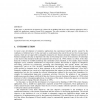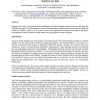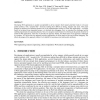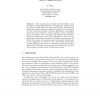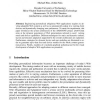IADIS
2003
14 years 25 days ago
2003
In this paper, we describe the development of a framework for building J2EE Web-centric business applications, that is, middle-size applications organized around Web components. T...
ISICT
2004
14 years 25 days ago
2004
Web applications have become the major means to allow ubiquitous access to backend systems via a web browser. Several technologies such as JSP, ASP.NET, or Java Server Faces exist ...
DGO
2003
14 years 25 days ago
2003
MapStats for Kids is concerned with the development of online learning activities based on data from the FedStats web portal. The development of these web applications requires th...
FLAIRS
2006
14 years 25 days ago
2006
Context can be seen as a paradigm aiming to improve user interaction with software. For Web applications in particular, the issues of content explosion and technological constrain...
IADIS
2004
14 years 25 days ago
2004
Developing Web applications is usually accomplished in ad hoc manner. Such manner generally results in very poor quality products, with "spaghetti-like" structures makin...
DIMVA
2006
14 years 25 days ago
2006
Abstract. The Internet, and in particular the world-wide web, have become part of the everyday life of millions of people. With the growth of the web, the demand for on-line servic...
EWIMT
2004
14 years 25 days ago
2004
Reasoning on the Web is gaining in importance because of emerging Web applications such as contextadaptive Web systems (e.g. eLearning, recommender, personalised (multi-)media, an...
DAIS
2006
14 years 25 days ago
2006
AJAX (Asynchronous JavaScript and XML) defines a new paradigm for writing highly interactive web applications. Prominent web sites such as Google Maps have made AJAX popular. Writi...
BXML
2004
14 years 26 days ago
2004
Abstract: Engineering personalized ubiquitous Web applications requires to develop adaptable Web content as well as to automatically adjust it to varying client devices and dynamic...
SEDE
2007
14 years 26 days ago
2007
Flexibility and adaptivity are two of the outstanding characteristics of new media and new technologies. These properties allow new methods to provide physically challenged people...
